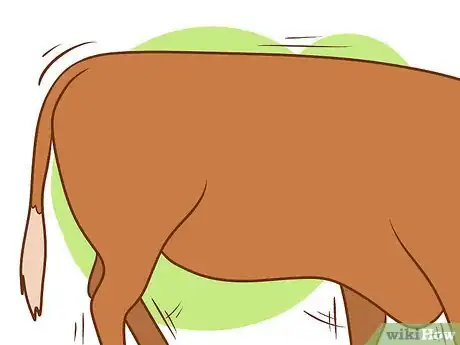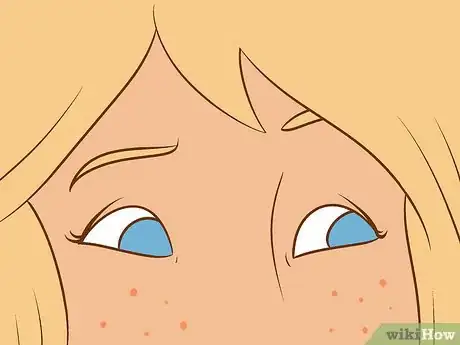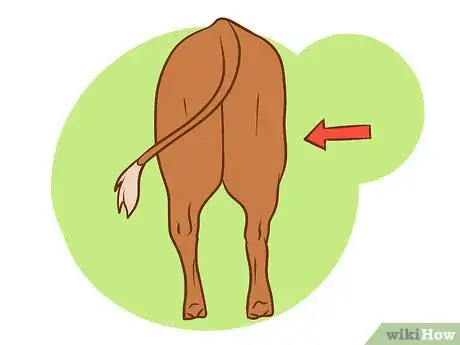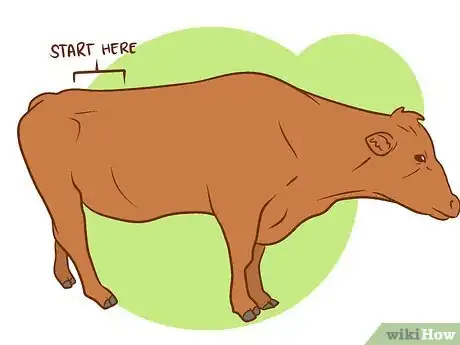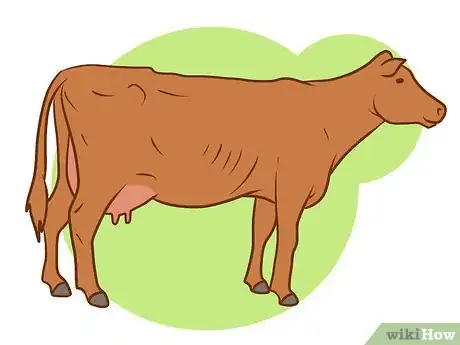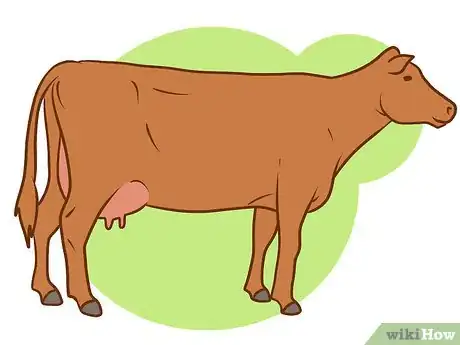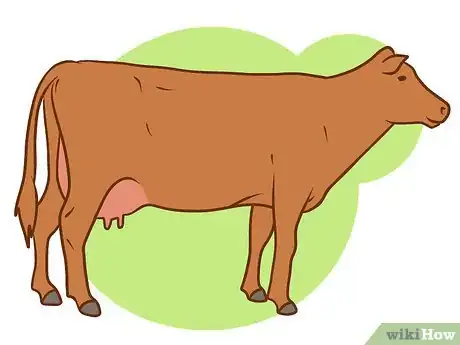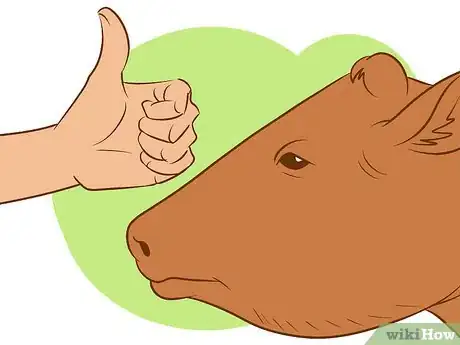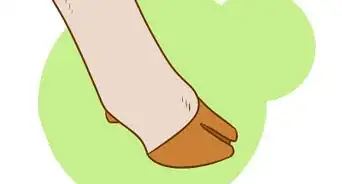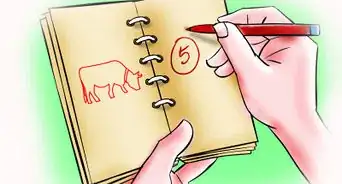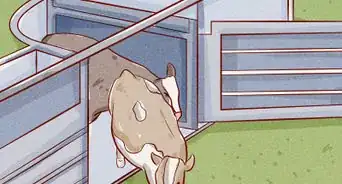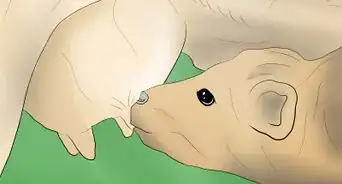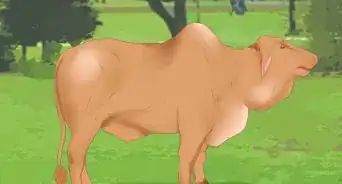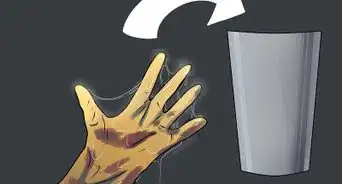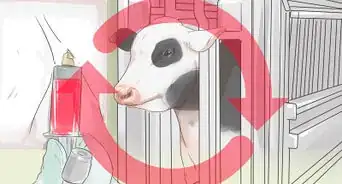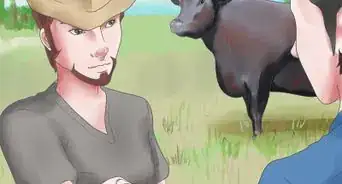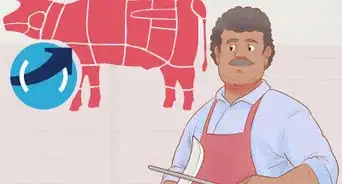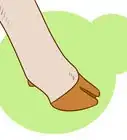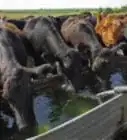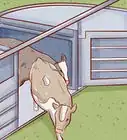This article was co-authored by Karin Lindquist, a trusted member of wikiHow's volunteer community. Karin Lindquist earned a BSc in Agriculture as an Animal Science major from the University of Alberta, Canada. She has over 20 years of experience working with cattle and crops. She's worked for a mixed-practice veterinarian, as a sales representative in a farm supply store, and as a research assistant doing rangeland, soil, and crop research. She currently works as a forage and beef agriculture extension specialist, advising farmers on a variety of issues relating to their cattle and the forages they grow and harvest.
wikiHow marks an article as reader-approved once it receives enough positive feedback. In this case, 93% of readers who voted found the article helpful, earning it our reader-approved status.
This article has been viewed 103,097 times.
Learn more...
Body condition is one of the most important things to know about when raising cattle. In breeding animals (cows, heifers and bulls), body condition is closely related to the fertility and forage convertibility. In beefers (steers and heifers raised for beef production), it determines health, ability to gain, and when the animals are ready for slaughter. It is suggested that your cattle have good conformation and be in the recommended body condition.
For the following steps in this article, you are free to use whatever score you like, though the Canadian score will be used below.
Steps
-
1Understand what body scoring is. Body condition scoring (BCS) is, by definition, the level of fatness on the body of an animal. There are two different scales of scoring that one can use for judging condition in cattle:
- 1 to 9, which is the American scoring system (or some refer this as the Beef Cattle scoring system); or
- 1 to 5, which is the Scottish (or Canadian) scoring system, or, for some, the Dairy Cattle scoring system.
- One (1) refers to extreme emaciation, and 5 (or 9) refers to overly fat or obese.
-
2Get the cattle in. Round up the cows using proper herding techniques to get them in the handling facility and to the crush or squeeze chute.
- Body condition scoring, especially with beef cows, needs to be done when they are restrained. Some cows can be so tame that they will let you touch them, but most should be restrained with a head-gate to do the scoring.
Advertisement -
3Eye up the general condition of the cow. Using your eyes is one way to judge body condition, but this can be difficult with cattle, like Highland or Galloway cattle, because the thick hair hides a lot of what you can feel by touch. Cattle that have their winter coats on will also pose the same issue for you.
-
4Work on the animal's right side. The rumen on the left will only hinder your ability to do a proper scoring on the cow.
-
5Start with the area over the last rib and the spine above that point. The area between the last rib and the hooks (first hip protuberance) is a major area that is used for judging BCS. Note the fat covering over the ribs and spine of this area. Then work your way over the hooks and pins, the thurl and the tailhead of the animal. Note the following (using the Canadian or Dairy Body Condition Scoring method):
-
BCS of 1: Entire animal will be extremely thin; this will be very noticeable in cows that have a short hair coat. All skeletal structures are visible, with no fat in the tail docks or brisket, nor will there be any muscle tissue or external fat present. Individual vertebrae on the spine are evident, and you should be able to place your fingers in between each vertebrae. The short ribs are visually prominent, and they feel sharp to the touch. The thurl over the hip is sunken in, and the hooks and pins are very sharp and prominent.
- Animals of this score are much too thin, and are a cause of great concern to those involved in animal rescue societies like the SPCA and even animal-rights people.
- Cows this thin do not have a good survival rate because of the lack of fat and muscle tissue in and over their bodies; malnutrition and sickness is a very high risk for animals in this condition.
- Cows will have a lot of trouble calving out with a BCS of 1 because of the lack of stored energy (fat) and muscle tissue they need when dealing with the stress of calving, thus dystocia will be a big problem for her. Emaciated cows will give little to no milk after calving, and will come back into estrus very late, unless she is given the proper feed and nutrition to help her gain weight.
- Emaciated and thin cows eat a lot because of their condition, and because cattle are capable of a weight-gaining process called compensatory gain. Thin cows have a higher temperature threshold than fat or normal condition cows because of the lack of fat and energy reserves needed to survive cold weather.
- Animals of this score are much too thin, and are a cause of great concern to those involved in animal rescue societies like the SPCA and even animal-rights people.
-
BCS of 2: The entire animal is thin, with the upper skeleton prominent, and there is some muscle tissue present. There is also some tissue over the tail dock, hip bones and flank. Individual vertebrae can be felt in the backbone, but they are not sharp. You shouldn't be able to place your fingers in between the vertebrae. Individual ribs can also be felt, though they will not be as sharp as with the BCS of 1.
- Though deemed thin at this point, she will not be as high at risk for malnutrition or illness as a cow with a BCS of 1. However, she will breed back later and have more calving issues, and still needs to gain weight in order to be conceived as a healthy bovine.
-
BCS of 3: This is ideal condition for calving. The ribs are slightly visible, and the hooks and pins are visible, but not prominent. Muscle tissue is nearing its maximum, and there is fat already forming behind the shoulder and in the brisket area. The backbone is somewhat defined, but it'll be difficult to feel the tops of the vertebrae. The short ribs are completely covered with fat, with the fat beginning to spread over the rump, and individual ribs can only be felt with firm pressure.
- Cows in this condition are the ideal keepers, even though they are considered to be on the borderline of being thin. They are much more likely to calve out on their own with little to no difficulty, and are also able to produce adequate amounts of milk for their calves.
- Feed costs are certainly lowered when you have cows of this condition (or higher) because they are not eating as much nor have as high a nutritional requirement as cows that are below this condition score.
- Critical low temperatures are lower for cows like these (at around -20ºC/-4ºF), making them more able to survive and even thrive in the wintertime.
- However, your cows should not be in this condition going into the winter months; this is the condition they should be in when the spring grasses start to grow and they can regain their weight lost in the winter.
-
BCS of 4: The skeletal structure will be difficult to identify, because there are obvious fat deposits behind the shoulder, at the tailhead, on the brisket and over the shoulder. The back will have a flat appearance over the top-line, and individual vertebrae cannot be felt. Folds of fat are beginning to develop over the ribs and thighs, and individual ribs cannot be felt even with firm pressure.
- Cows are deemed as moderately fat to fat at this point, but this is also the optimum condition cows should be in when going into the winter months, because this means that they can be fed a lower quality feed or be on low quality pasture without too much worry about malnutrition concerns during wintertime. They will lose weight over winter, of course, as this is natural for any herbivore going into the most difficult season of the year.
- However, some cows at this condition may have a few issues with calving and milking ability than cows with a normal BCS of 3. This is because fat deposits start to form around the birth canal make calving out more difficult (fat deposits hinder the birth canal's ability to stretch far enough to allow the delivery of a calf), and fat deposits in the udder may have the cow to produce less milk than what is needed.
- Between BCS of 4 and 5 is the best condition to move backgrounded cattle onto the feedlot, or for small-time farmers to have their steers slaughtered.
- Cows are deemed as moderately fat to fat at this point, but this is also the optimum condition cows should be in when going into the winter months, because this means that they can be fed a lower quality feed or be on low quality pasture without too much worry about malnutrition concerns during wintertime. They will lose weight over winter, of course, as this is natural for any herbivore going into the most difficult season of the year.
-
BCS of 5: This is the point where the bovine is considered obese. The animal will have a blocky look about it, with a dominating flat appearance. The brisket will be heavy with fat, and the hips and tailhead of the animal will be pretty well buried in fat. The animal will have a flat back and individual vertebrae cannot be felt at all. The short ribs are not present because they are completely covered by fat. Mobility may be impaired because of the excess of fat.
- As mentioned above with BCS of 5, calving and milking ability will be hindered for cows in this condition. Cows that have a BCS of 4 or greater need to be put on a low-quality diet so that they will lose weight in time for breeding and/or calving season.
- Bulls in this condition will experience fertility issues because fat deposits in the scrotum increase the temperature of the testes, which will harm proper sperm production.
- North American meat packers downgrade carcasses that are overly fat because of the excess fat that needs to be trimmed off and the excessive marbling.
- However with the Japanese Kobe beef, animals that are at this condition are considered desirable since beef with this high of marbling is considered a delicacy.
- As mentioned above with BCS of 5, calving and milking ability will be hindered for cows in this condition. Cows that have a BCS of 4 or greater need to be put on a low-quality diet so that they will lose weight in time for breeding and/or calving season.
-
BCS of 1: Entire animal will be extremely thin; this will be very noticeable in cows that have a short hair coat. All skeletal structures are visible, with no fat in the tail docks or brisket, nor will there be any muscle tissue or external fat present. Individual vertebrae on the spine are evident, and you should be able to place your fingers in between each vertebrae. The short ribs are visually prominent, and they feel sharp to the touch. The thurl over the hip is sunken in, and the hooks and pins are very sharp and prominent.
-
6Note the body condition score of each cow that you do. It would help to write down which cow has what condition score, so you can later on determine if any of the thinner cows need to be separated from the fatter ones.
-
7Repeat with other cows that are to be scored.
Community Q&A
-
QuestionAt what age should I replace a cow?
 KarinTop AnswererIt really depends on the other factors of that cow besides age. Her teeth, her fertility, udder condition, calving ability, mothering ability and feed conversion ability as dictated by the biennial BCS check should be the more dominant deciding factors over age. However, cows that get to be at least 10 to 15 years of age have a higher chance of ending up on the cull list than younger cows with their second calf.
KarinTop AnswererIt really depends on the other factors of that cow besides age. Her teeth, her fertility, udder condition, calving ability, mothering ability and feed conversion ability as dictated by the biennial BCS check should be the more dominant deciding factors over age. However, cows that get to be at least 10 to 15 years of age have a higher chance of ending up on the cull list than younger cows with their second calf. -
QuestionHow fat should a cow be before joining with the bull, and when is the best time?
 KarinTop AnswererAs noted in the article above, the cow should be at a BCS of 3 to 3.5 (on a 1 to 5 scale) or 5 to 6 (on a 1 to 9 scale) to be in good condition for breeding. When to breed depends on when you want her to calve. This is dictated by fly season, winter season, muddy/wet season, etc. Estimate about when you want her to calve, and count backwards by about 9.3 months.
KarinTop AnswererAs noted in the article above, the cow should be at a BCS of 3 to 3.5 (on a 1 to 5 scale) or 5 to 6 (on a 1 to 9 scale) to be in good condition for breeding. When to breed depends on when you want her to calve. This is dictated by fly season, winter season, muddy/wet season, etc. Estimate about when you want her to calve, and count backwards by about 9.3 months.
Warnings
- Cows may kick if they don't like to be touched in the hind quarters.⧼thumbs_response⧽
- Body condition scoring may be difficult for those who don't have the experience or knowledge of how to properly score an animal. Make sure you have studied different pictures of animals of particular condition scores to accurately know what is involved.⧼thumbs_response⧽

